Sara Bäckmo at Solliden Palace 2023
Welcome to my garden blog at www.sarabackmo.com. This is where you'll find information about my exhibition at Solliden Palace.
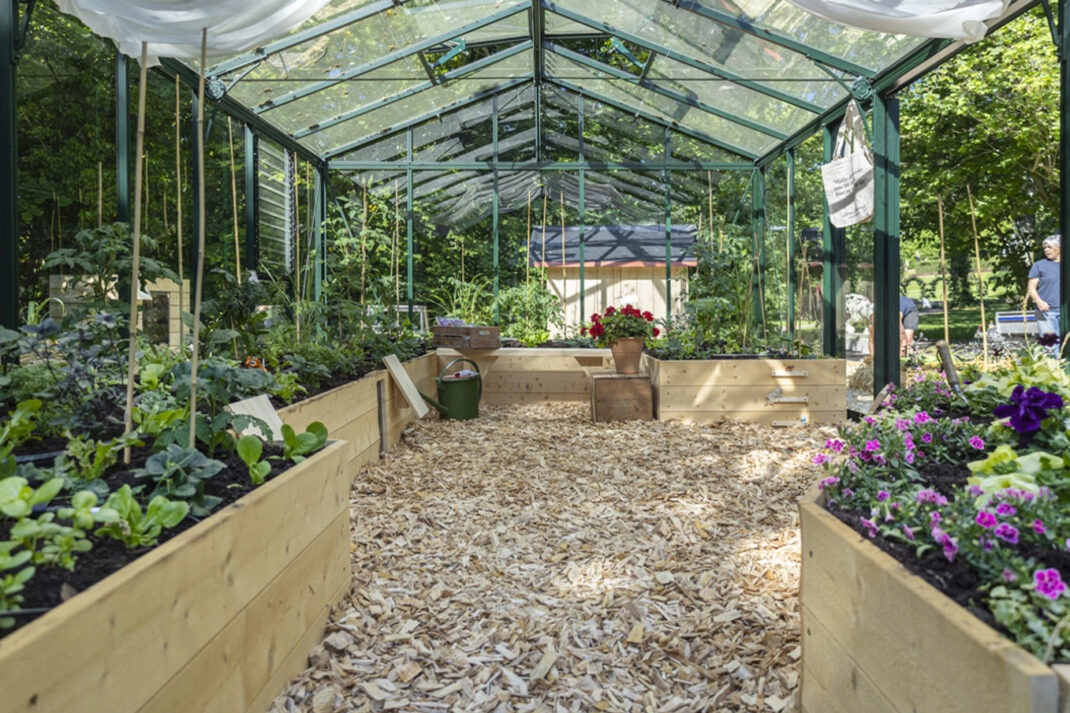
Foto: Anna Broette
Here you can find information about my exhibition in one of the greenhouses at the Solliden Palace at Öland.
Sara Bäckmo & Skillnaden's Flower Farm & Nursery
Welcome to my garden exhibit at Solliden! My name is Sara Bäckmo, and I am a vegetable grower, author, and gardening enthusiast from Kalvsvik in Kronoberg County. I have put together this exhibition in collaboration with my colleagues at Skillnaden’s Flower Farm & Nursery in Kalvsvik: Anna-Stina, Göran, Margit, Tuve, Anna, Åsa, Agnes, and Fredrik.
The thing I enjoy the most is inspiring people to grow, especially vegetables. Being able to cultivate your own food brings so much joy and meaning!
Feel free to browse through one of my books here in the greenhouse or read my articles in English at www.sarabackmo.com
I would love for you to taste the vegetables here in my garden at Solliden! If you find something you like, perhaps you would like to grow your own vegetables at home? It is easy to find cuttings or seeds for almost all of the plants presented in this garden.
Good luck with your own gardening endeavors,
Best regards,
Sara Bäckmo
Wood
Wood is an excellent building material for the garden. It's a natural material that blends nicely with the plants. I receive many questions about wood selection and have enlisted the help of Martin Greider, a salesperson at Fellessons Building Supply in Växjö, to answer some of them.
Which type of wood is suitable for garden projects?
The most common choice is untreated and rough-sawn spruce. Rough-sawn wood is suitable for constructing raised beds and can easily be painted with traditional flour pain, for example. Planed wood has smooth sides and is more suitable for surfaces like benches and similar projects.
Should I avoid pressure-treated wood?
Pressure treatment makes the wood more resistant to rot. The treatment used today is gentler than in the past, but there is still a risk that the chemicals used may leach into the soil where they can get absorbed by the crops. The recommendation is to not use pressure-treated wood in vegetable gardens.
How long does wood material last in the garden?
The lifespan varies greatly depending on the dimensions of the wood used. Thinner materials have a shorter lifespan, while thicker materials last longer. A typical raised bed usually lasts 5-7 years.
Why do you have wood chips on the ground?
Wood chips create a nice appearance, and it is also a pleasant material to walk on. The wood chips help bind the different areas together and create a cohesive look. You can get your wood chips from companies working in land preparation or directly from your local sawmill.
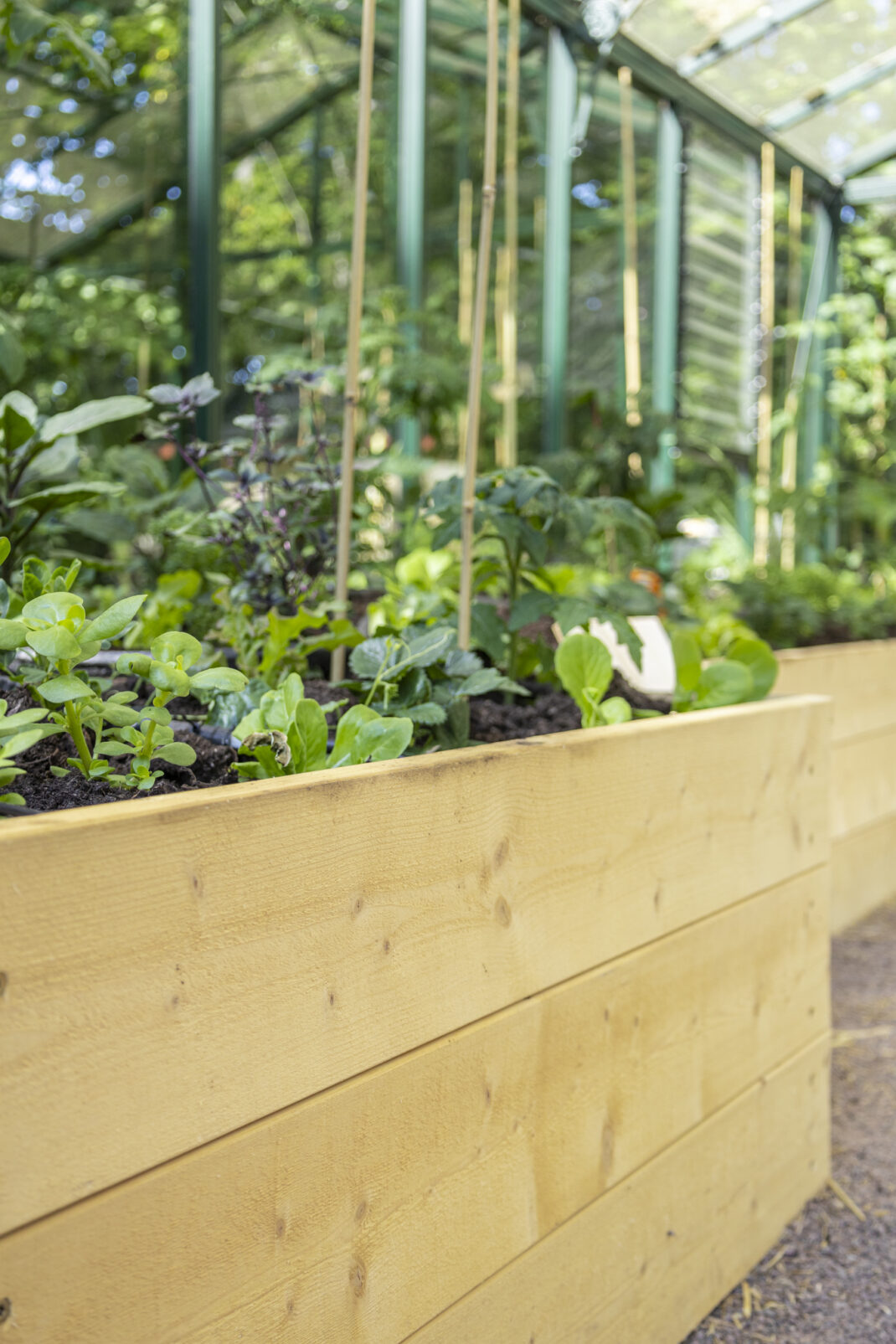
Photo: Anna Broette
Growing in silage
All the raised beds in the garden were created with silage. Silage is fermented grass or grain that contains a lot of nutrients. We have placed a compostable ground cover directly on the lawn (no digging), and then added around 20 cm of silage on top. You can also use newspaper or cardboard instead of the ground cover if you want. When the silage is kept moist, it starts to decompose. And within two years, it will turn into soil. This is a great method to create new growing areas quickly. You can easily make large raised beds like this, instead of removing the lawn and adding new soil on top.
We plant in the silage by making small holes where we add a little soil, and then we plant the seedling there. All types of plants can be grown in silage, but direct-sowing in the silage bed can be a little bit challenging. My favorites to grow in silage are brassicas, tomatoes, cucurbits, and celeriac.
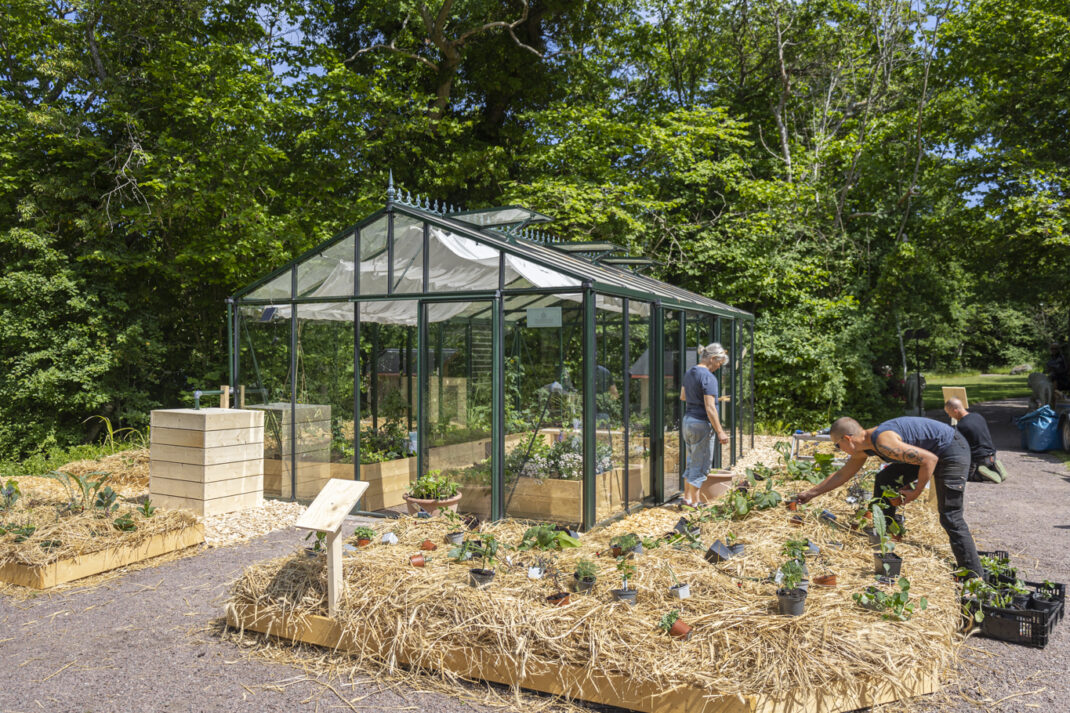
Foto: Anna Broette
Pressurized irrigation
The irrigation system in the silage beds is a type of pressurized irrigation. It is connected to a water hose or an external water pump. The pressurized irrigation distributes water through a supply line at the back of the raised beds and further into smaller hoses connected to spray nozzles that are tailored to our type of cultivation.
Pressurized irrigation can be combined endlessly with different nozzles and drip irrigation solutions. Providing water to the plants before they desperately need it is essential when growing vegetables, especially during hot summers. Drip irrigation, from a long hose with holes, reduces water consumption by approximately 70% compared to watering with a regular hose and sprinkler. Pressurized irrigation can also be connected to a rain barrel or pond, for example, through an external pump.
It is particularly smart to connect an irrigation controller to the system, which waters at specific times according to a schedule.
Our irrigation system includes parts from Gardena MicroDrip.
Solar-powered irrigation
We use solar-powered irrigation from Impecta Fröhandel in the greenhouse. The small pumps here are powered by batteries that get charged by the sun. The more sunlight the unit gets, the more the batteries charge. Every three hours, the irrigation starts and waters for as long as the batteries last.
Solar-powered irrigation can be used together with the smart irrigation hose that is laid on the ground (25 meters long) or through convenient drip nozzles. A total of 24 drip nozzles can be used for the C24L system we use here.
The irrigation pump is completely independent and does not need to be connected to the electrical grid or water outlet. The suction hose is placed in a water barrel and can, for example, water with rainwater or reasonably clean graywater during a dry summer.
Solar-powered irrigation makes it possible to cultivate in dry areas with minimal maintenance. It works great for the outdoor beds as well as the greenhouse. It is also invaluable for those who need a remote solution for their vacation home or perhaps an allotment.
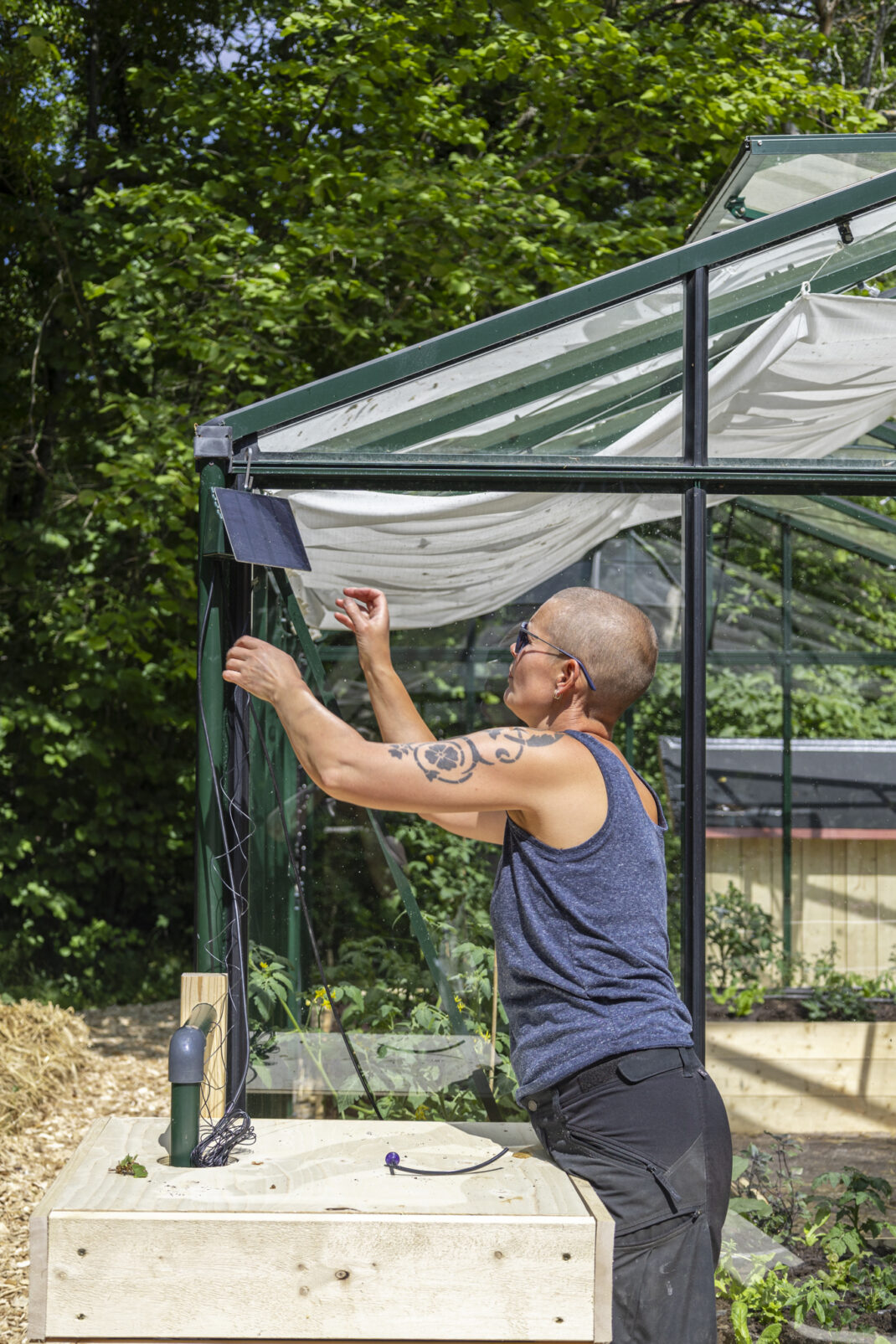
Photo: Anna Broette
The compost
Every garden should have a compost. It's both practical and fun! We created a compost here at Solliden so that you can check what it looks like. Do you see any worms?
You can add mixed plant materials from the garden as well as kitchen scraps to your compost. When microorganisms interact with the compost material, decomposition begins. Our compost pile was completely full in June, but the material settles as sinks as time goes by. If you want to, you can put two compost piles side by side. When one is full, you simply start filling the other. And when the second one is full, you empty the first one that now contains nutrient-rich soil that you can use in your garden!
Our compost pile has a removeable section in the back that can be unscrewed when it's time to empty the pile.
A compost pile is full of nutrients! That is why you should make use of the pile already before turns into soil. You can do this by growing something directly in the pile. Pumpkins, cucumbers, cabbage, tomatoes, and other annual plants thrive in the compost. Don't forget to water if it's dry! You can place a simple bucket with small holes in the bottom on top of the compost pile. This is a smart way to create homemade drip irrigation system. Top the bucket off with water (perfect for graywater during dry summers) whenever you pass by.
The peep hole
In this peep hole, you can take a closer look at the raised bed and see how it is constructed. If you want to build tall raised beds, it is advisable to fill them with something other than soil too. Store-bought soil is often made from peat, which you want to avoid wasting here. It's better to fill your raised bed with other materials and place soil on top where you want to plant or sow. The material at the bottom will compost and turn into fine nutrient-rich soil over time. Remember that you need to keep improving your soil. Incorporate compost, manure, water with liquid fertilizer, or cover the soil with grass clippings.
In the peep hole, from top to bottom, you can see:
- soil
- kitchen scraps
- green leafy matter
- guinea pig manure
- silage
- bark
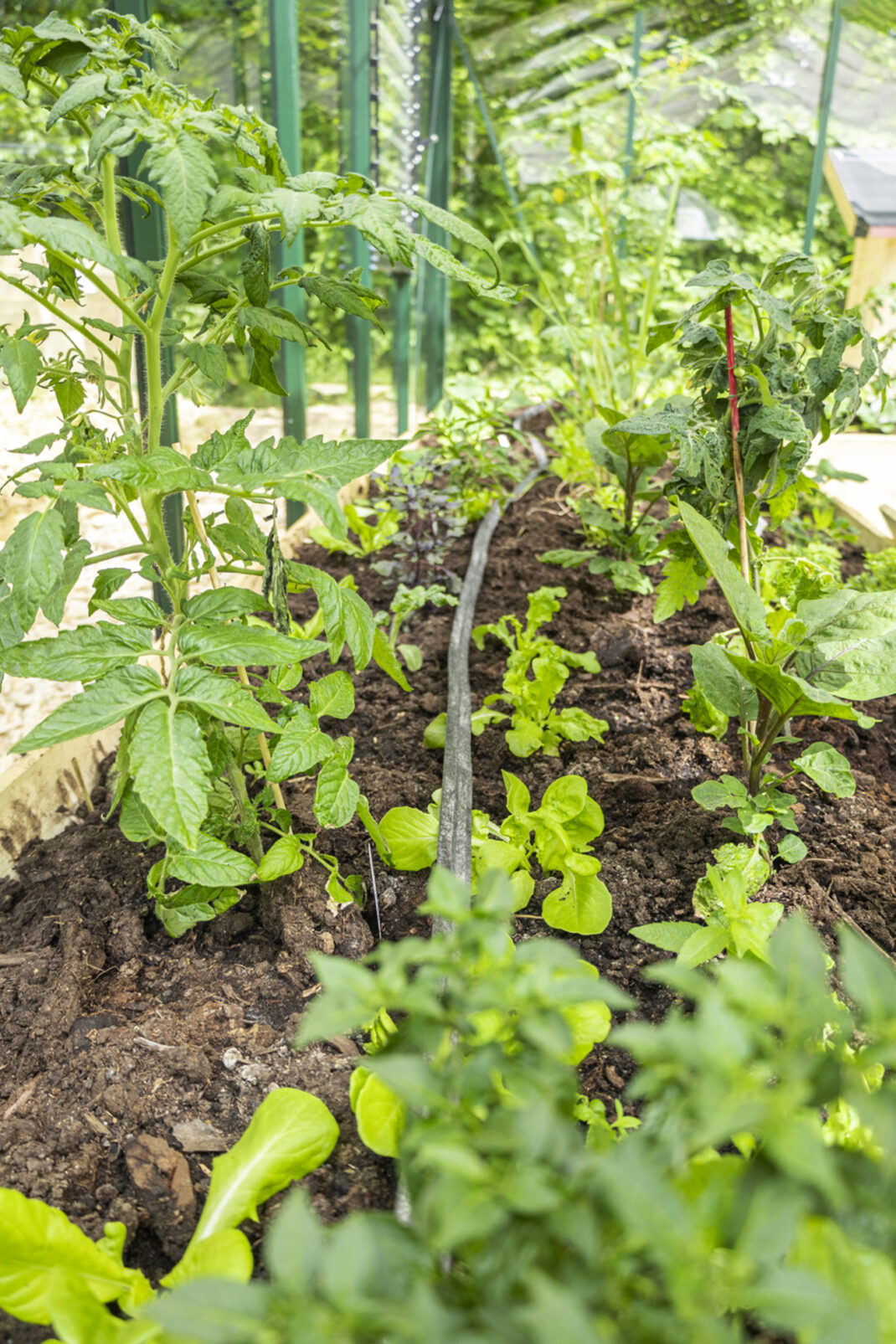
Foto: Anna Broette
Greenhouse plants
There's no limit what you can grow in a greenhouse! We decided to go for a mix of purely edible plants in our large bed. We would love for you to taste the plants you recognize! You don't have to eat the entire vegetable if you don't want to; you can put the leftovers in the compost behind the greenhouse.
Edible plants in the greenhouse include:
- tomato
- lettuce
- eggplant
- cucumber
- melon
- strawberry
- lemongrass
- basil
- peanut
- chili
- sweet potato
- passion fruit
- oxalis
- tomatillo
- physalis
- melon
- strawberries
- thyme
- lemon verbena
- purslane
- cucamelon/mouse melon
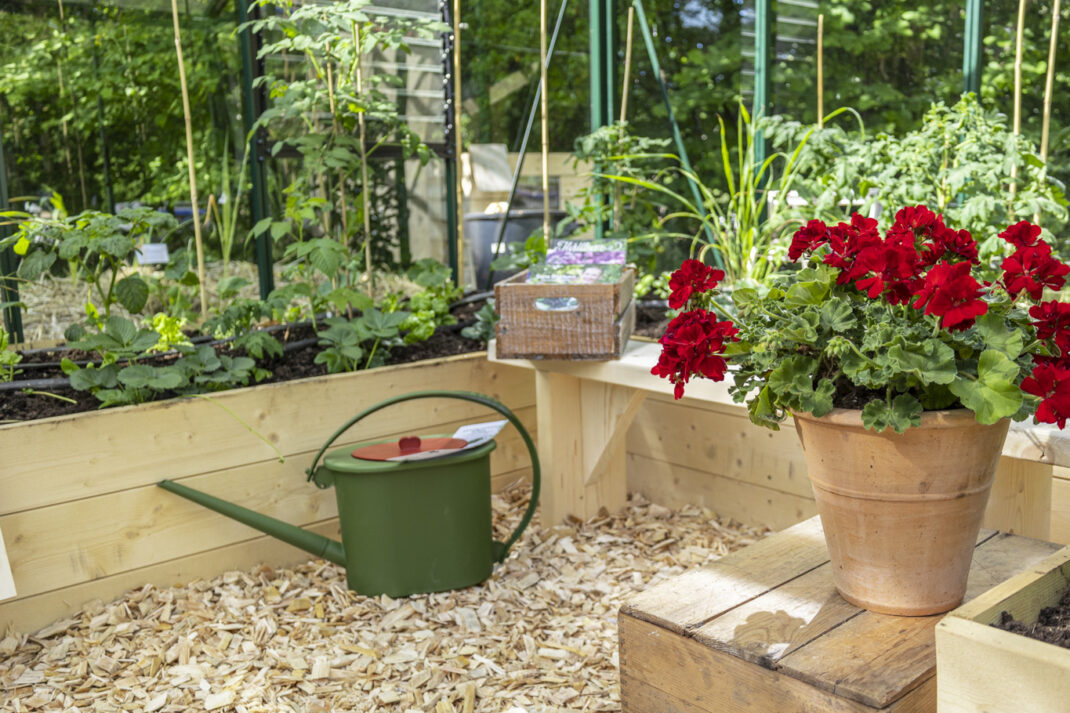
Photo: Anna Broette
Outdoor plants
Most vegetables can actually be grown outdoors in Sweden. Only a handful require so much warmth that they need to be in a greenhouse. Of course, gardening in the far north is more challenging because of the cold. Some plants that thrive outdoors in southern Sweden might need to be kept in greenhouses up north.
In large parts of the country though, it is perfectly possible to grow tomatoes, bell peppers, cucumbers, eggplants, chili peppers, basil, physalis, and tomatillos outdoors. In outdoor beds, we often have space for more plants than in a greenhouse too.
One of my best tips for choosing plants for your outdoor beds in this climate is to look for varieties with a shorter cultivation time. Almost all tomato varieties sold in Sweden are suitable for outdoor cultivation, where it is easy for insects to handle pollination.
In our ensilage beds, we grow a mix of vegetables and flowers, inspired by my gardening friend Anna in Umeå. She calls this style of growing "hodgepodge" gardening, and I think it's lovely!
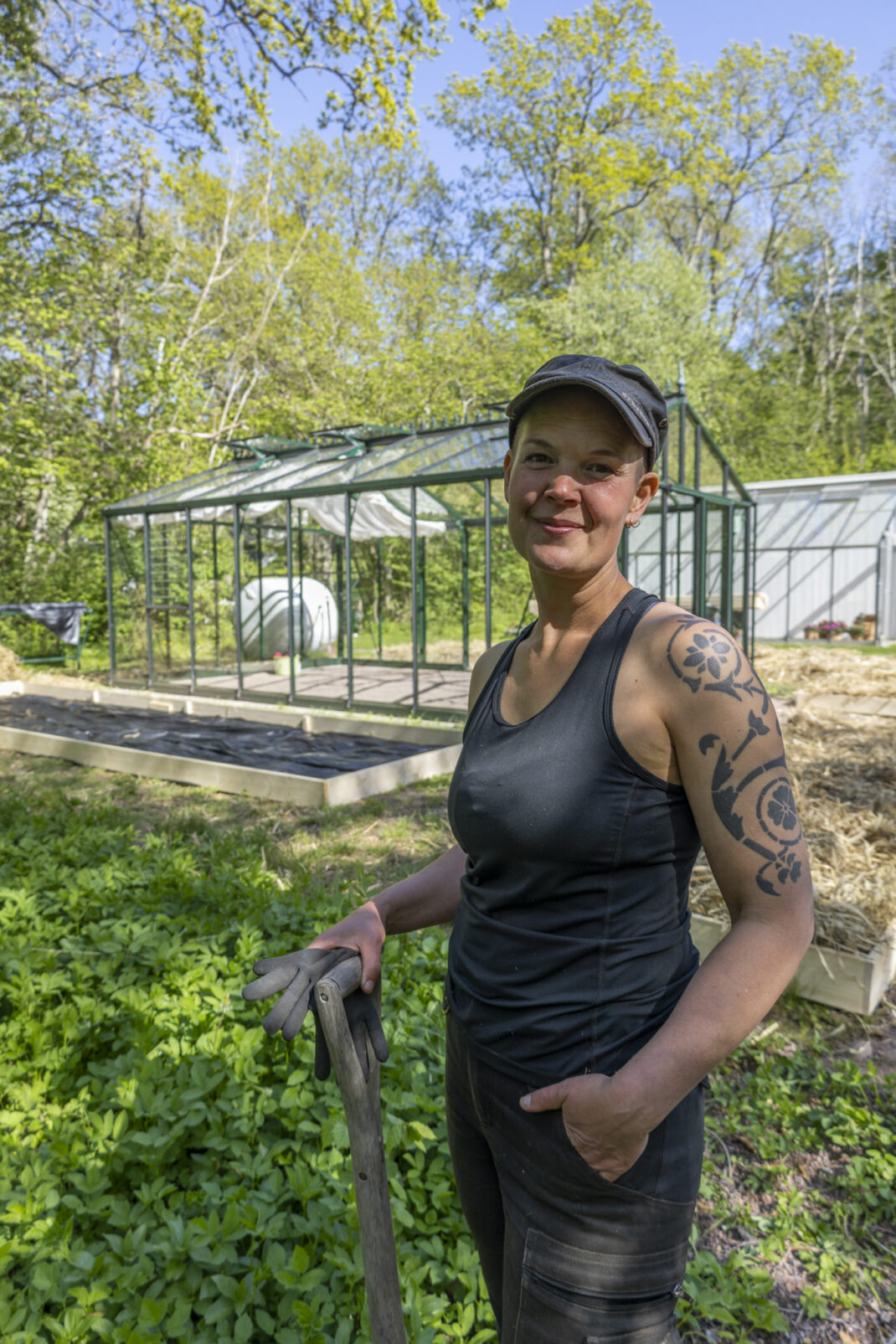
Foto: Anna Broette
The flower farm & nursery in Kalvsvik
Since January 2022, I have been running Skillnadens Handelsträdgård (Skillnaden’s Flower Farm & Nursery) in Kalvsvik, together with the previous owner, Anna-Stina Gustavsson. It is Anna-Stina who created this bed, with a mix of her favorite ornamental plants from the farm.
Anna-Stina took over the nursery from her parents, Holger and Margit Larsson, in the 1990s. The flower farm and nursery opened already in the early 1950s, so it has been around for over 70 years, with production of cut flowers, ornamental plants, bulbs and vegetable seedlings. There is a wealth of knowledge and experience about different plants, cultivation, and techniques here.
Today we are three generations of women working together in cultivation, sales, and inspiring others to garden through our work. Anna-Stina and her mother Margit (96 years old) are the main reason why we are presenting this exhibition to you. When I was asked to participate, Anna-Stina exclaimed, "We must do it, you don't turn down such an opportunity. It's an honor!" And she is absolutely right.
In my professional life, Anna-Stina is the person who has influenced me the most, with her extensive knowledge of gardening and entrepreneurship, her positive energy, and her impressive strength as a woman. Thank you so much, Anna-Stina! I hope we have many wonderful years together at our nursery.
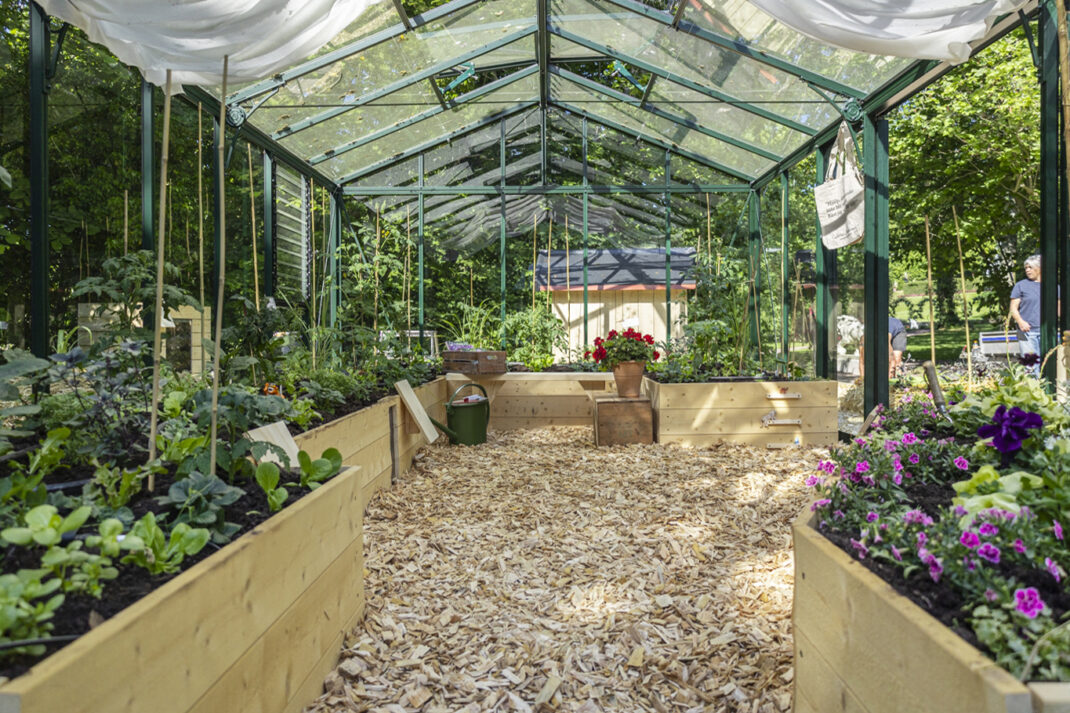
Photo: Anna Broette
The garden shop
During the harvest season, we have vegetables from the garden that the gardeners here at Solliden help us harvest in our shop. Please feel free to take something with you home, it is free! We have bags available for you too.
In my book "Skillnadens skörd – mat från trädgården året runt" (Skillnaden’s Harvest - Food from the Garden All Year Round), you can find many recipes for dishes made from the harvest throughout the year. The book is currently only available in Swedish, but we hope to translate it to English in the near future. If you want to buy a signed copy in Swedish, please visit my webshop www.sarabackmo.se.
Fertilizer
In my opinion, the best way to grow vegetables is to focus on the natural cycle. It benefits nature, wildlife, and the gardener too. This is something I always keep in mind when deciding which fertilizer to use in my gardens. To grow good vegetables, you often need more fertilizer than you might think. You also need to fertilize the beds more than once to get good results. There are several kinds of organic/natural fertilizers that can be used to grow vegetables, which improve the soil in the long term. Here are some examples:
Kitchen scrap compost: Let your kitchen compost decompose in a traditional compost bin, alternate it with plant material from the garden to create nutrient-rich soil for your pots and beds.
Bokashi compost: Ferment your kitchen compost and bury it directly in the soil. Worms love bokashi and can transform the compost into new, nutrient-rich soil within a few weeks.
Grass clippings: This is easily one of the most nutrient-rich materials from the garden. Use it as mulch and/or mix it with other plant materials and bury it in the beds.
Urine: Dilute 1 part urine with 10 parts water and water the soil in your pots and beds. Urine contains approximately the same amount of nutrients for plants as store-bought plant fertilizers. It's free and completely eliminates the need for transportation and packaging.
Nettle water: Weeds like stinging nettles and ground elder make excellent fertilizer! Let the plant parts soak in water for two weeks, then dilute the liquid with 10 parts water and water the beds with it. It may smell terrible, but it provides a quick and appreciated dose of nutrients to the plants.
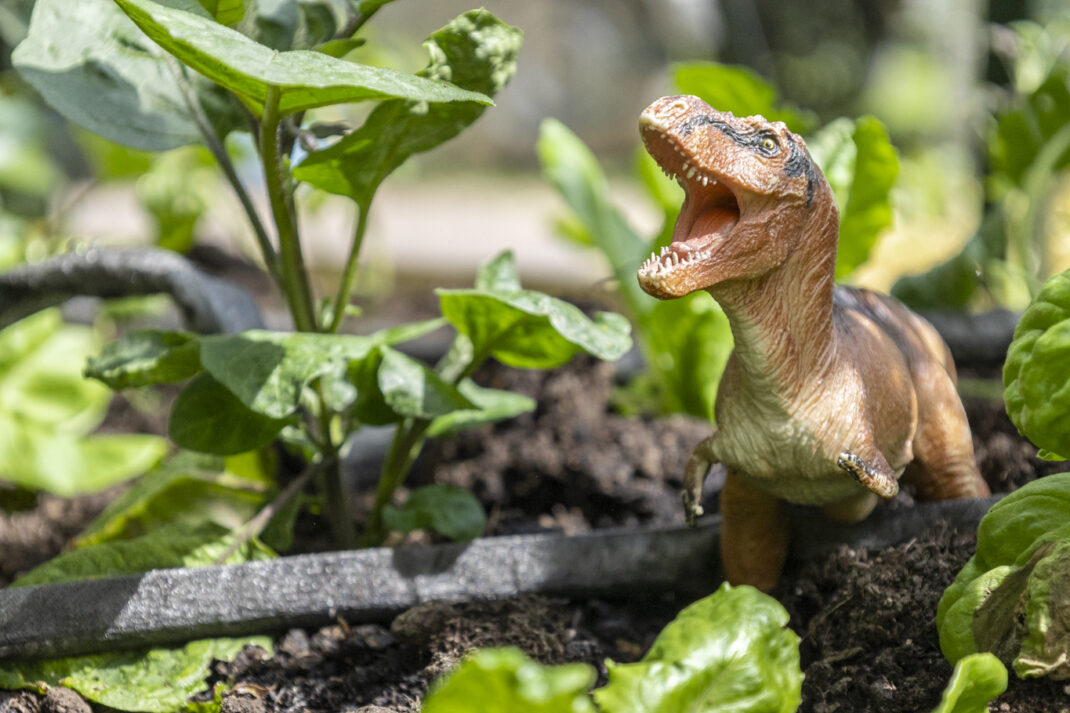
Foto: Anna Broette
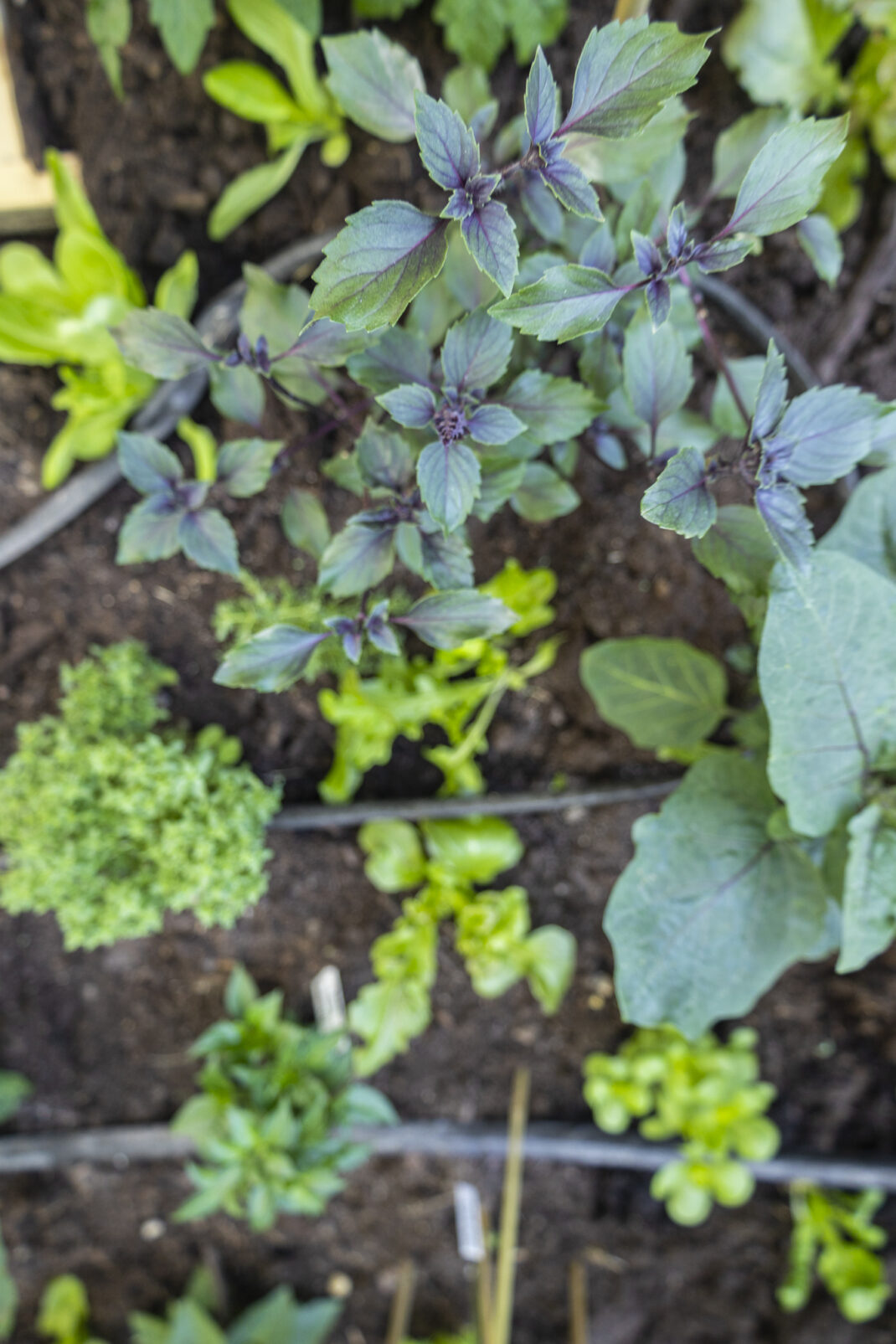
Foto: Anna Broette
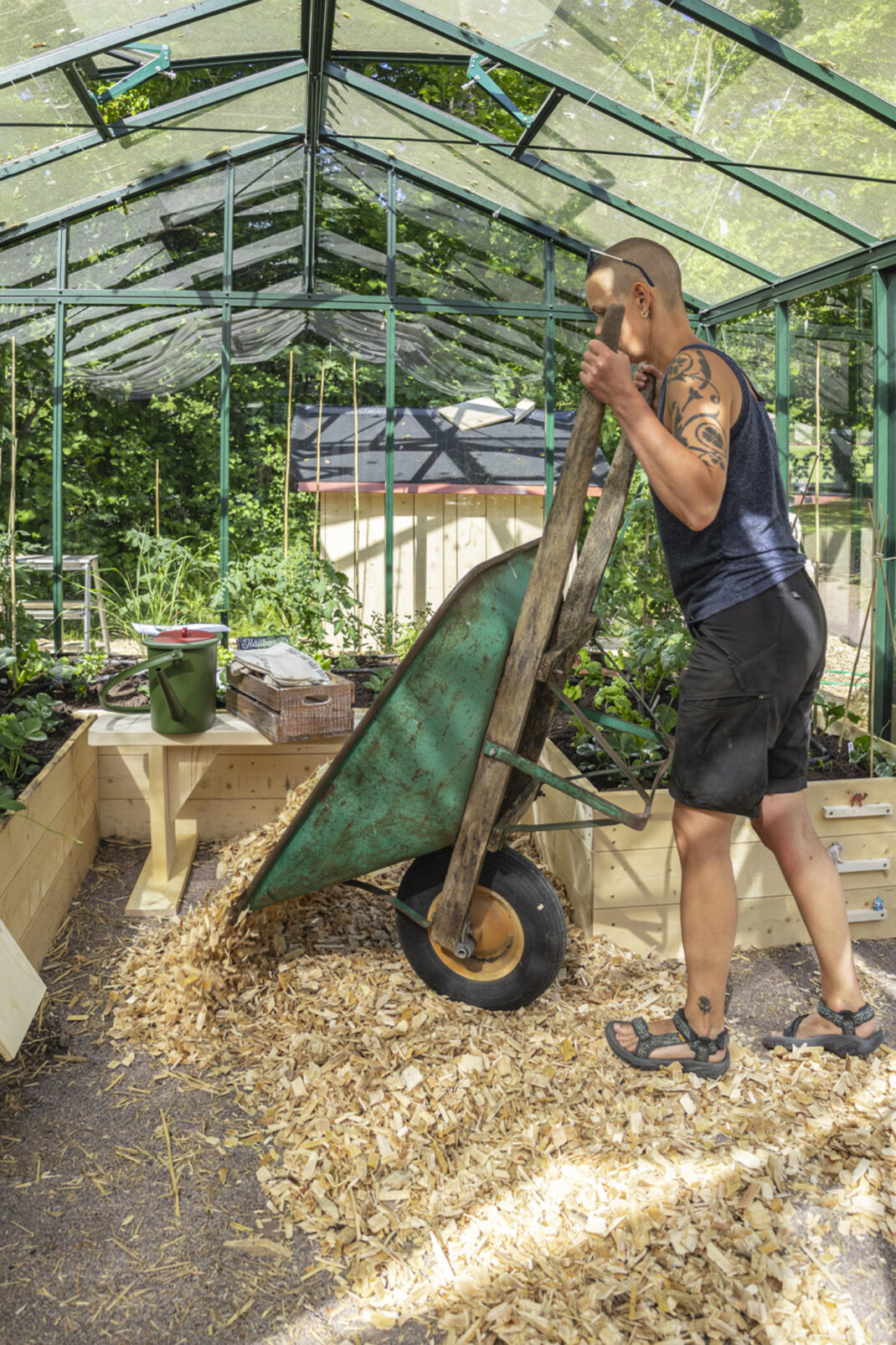
Foto: Anna Broette
14. June 2023
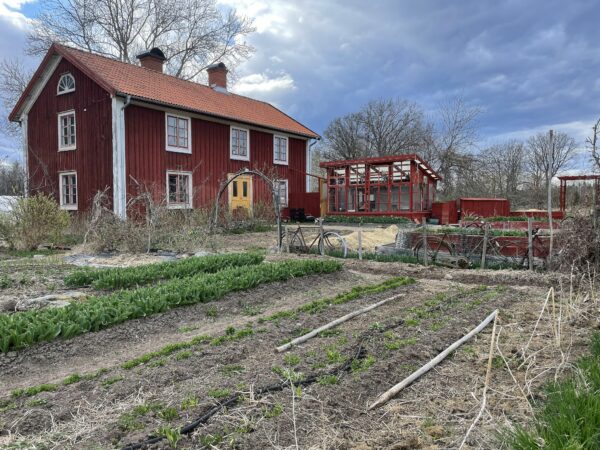
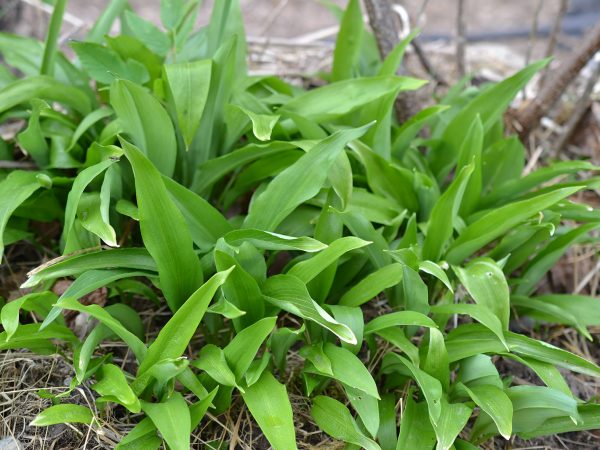
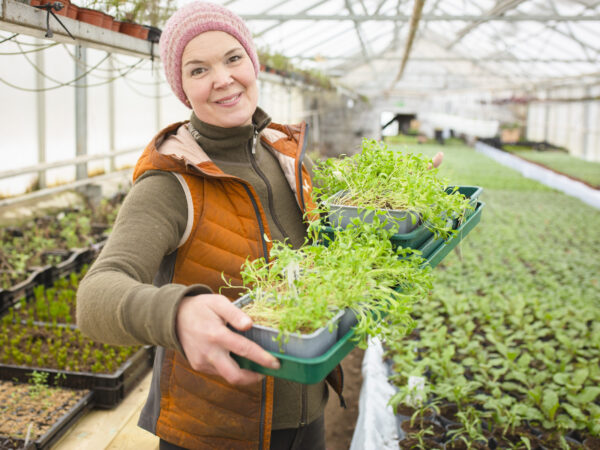
Leave a Reply